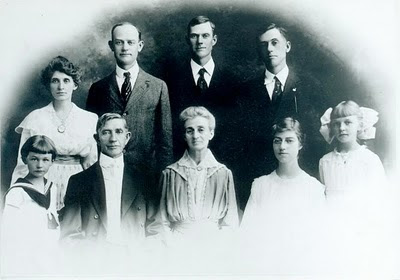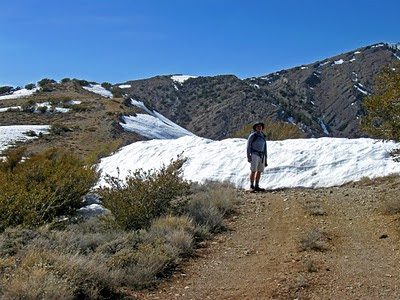Friends of the SALINE VALLEY SALT TRAM
www.SaltTram.blogspot.com SalineValleySaltTram@gmail.com
Salt Tram history is rapidly disappearing, and we are striving to rediscover the efforts of our forefathers in order to give proper recognition to their hopes, dreams and abundant sweat from an era that is rapidly fading from our memories. We are actively seeking out information about the mining of Salt in Saline Valley between 1903 and the 1950's, including: documents, photos, articles, stories, artifacts, etc. If you can help us out, please email us at the address above - Thank-you! --Tim and Brian Waag, the Waag brothers (aka E. Clampus Waagus).
Caution (PLEASE READ): Climbing around on the tramway is dangerous because its really old and defnitely unsafe, so don't even think about it. Shoot, just getting to it requires some perilous hiking, and if you don't believe me, just take a look at the Zig Zag Access Trail (or what's left of it). Plus, climbing on it weakens it and endangers your life. Also, the Saline Valley Salt Tram is on the National Register of Historic Places and should be treated with the respect that it deserves. What little remains is of great historic value, and should not be disturbed in any way. Heck, its probably against the law to move parts of the tram around, and certainly a crime to take home some of the few bits of it that remain (though you'd have to ask your friendly local BLM agent for details). So please treat it with the respect it deserves, so that future generations can enjoy whats left, without you messing it up. Really. Please. You can see its listing on the National Register of Historic Places at these web links:
National Register of Historic Places 1 National Register of Historic Places 2
*****************************************************************************************
QUESTION1: Find out as much as we can about Earl Patterson, Cliff's brother and co-worker on the building of the Salt Tram. When was he born? Did he marry and have children. What do we know about the relationship between brothers Cliff and Earl. Etc.
QUESTION2: Find out as much as we can about Burney Patterson, Cliff's brother. When was he born? Did he marry and have children. What do we know about the relationship between brothers Cliff and Earl. Etc.
*****************************************************************************************
We have been slowly working our way through the Inyo Register "IR" (Bishop, Cal.) and the Inyo Independent "II" (Independence, Cal.) during the Salt Tram era to advance our Salt Tram knowledge. While working on the years 1911 - 1913 in the Inyo Register, I decided to first review every page of the Patterson Diary for potential references that I would want to keep an eye out for while reviewing the IR. Specifically, I was looking for Construction Camp Names, Current Events noted in the diary that could be found in the IR, People and Animal Names noted in the diary, and cities or regions noted in the diary. Below is the result of that work.
Camp Names and References
12/1/1911 Dry Camp
12/21/1911 Gravel Pit
1/5/1912 Gravel Camp
2/13/1912 Dry Camp
2/17/1912 Telephone
2/25/1912 Gravel
3/8/1912 Gravel
3/8/1912 Charcoal
3/11/1912 Los Pinos
3/12/1912 Gravel
3/15/1912 Charcoal
3/29/1912 Gravel
4/2/1912 Gravel
4/3/1912 Daisy Canyon
4/10/1912 Daisy Canyon
4/23/1912 Gravel
5/4/1912 Daisy Canyon
7/15/1912 Camp at Station #26
7/21/1912 Flagstaff
7/22/1912 Flagstaff
7/21/1912 Flagstaff
8/23/1912 Daisy Canyon
9/14/1912 Daisy Canyon
9/30/1912 Sta. #7
11/30/1912 Terminal
1/16/1913 Station 29 (Control Station 4)
1/16/1913 Old Dry Camp
2/24/1913 Chuckawalla
3/20/1913 Chuck (awalla?)
3/25/1913 Chuck (awalla?)
3/26/1913 Chuckwalla
3/27/1913 Chuckwalla
3/28/1913 Chuckwalla
5/18/1913 Chuckwalla
5/19/1913 Summit
5/20/1913 Daisy
5/26/1913 Daisy Camp
6/2/1913 Summit
6/2/1913 Daisy Camp
6/3/1913 Daisy Camp
6/26/1913 Moved up to (station) 29
7/9/1913 Deep Canyon
7/10/1913 Deep Canyon
Topics to look up in the Newspaper
12/13/1911 Voted Dry
8/21/1912 Went to the Trial of Zachary
9/13/1912 Chas. Bigelow got drowned.
10/22/1912 Layed out Saline terminal and check up bolts and shortage of towers up to Tower #29.
10/29/1912 Another Englishman came.
4/21/1913 Bunch of Big Guns came.
4/28/1913 Japs came down.
People/Visitors and/or Animal Names
12/8/1911
White [Smith] came up to see us today
12/15/1911 Left Bishop for Swansea with
Will Smith
12/17/1911
White [Smith] came up and learned to concrete
12/21/1911 Packed up
Beanny with
Earls and my beds … then loaded them on
Boots wagon
12/22/1911 …did some surveying for
W. Y. Davies
12/26/1911 Ate Turkey Dinner at
Dr. Stofflets
1/4/1912 Moved down to Saline and helped
Mr. Wickham with cross sectioning…
1/5/1912 Went up to where muled got Killed and got
Apperajo
1/6/1912
Al, Earl and I leveled up T’s…
1/10/1912
White and
Will came down tonight in the Auto.
1/18/1912
Earl and
Al went up and leveled Tower #20 Section 5.
1/30/1912
White and
Will came in the Auto.
2/25/1912 Slept in
Bowman’s Tent.
2/27/1912 Graded out for Tents in A.M. and worked on Station #26 in P.M.
Al, Earl and I.
2/28/1912 Put up Tents in A.M. & worked on 26 in P.M.
Earl & I and
Al a part of A.M.
3/8/1912 Went to Gravel & got
Trix and packed 1 sack grain to camp…
4/30/1912
White, Pen & another
Tenn. Gink and
Dad came up to got Summit.
5/1/1912
Dad went to Saline.
5/6/1912
Wallace took
Williams place.
5/19/1912 run levels in PM with
Mr. Wickham.
5/22/1912 …Then had to tear out 7 & 8 on acct of mixup of
Kuhn lo’s
5/24/1912
Jeff &
Tolly cut off anchor bolts in afternoon
6/4/1912 Took shore line & levels of Lake with
Earl.
6/7/1912 Run levels for
Coward AM.
6/9/1912 Layed out Vats for
Coward.
6/11/1912 Layed out Vats #2, 3, & 4 East for
Coward & set elev. For #2
7/16/1912
Earl went to Swansea to mail letter.
7/23/1912
White came up and gave me a letter from
Fred.
7/21/1912
Reed & one of
Ben’s gang put up tent at flagstaff.
7/22/1912
Jeff, Bill and two of
Ben’s crew commenced excavating on small piers…
7/23/1912
Jeff put up Shop and
Meeker flunkied.
7/26 – 8/21/1912 Cliff vacationed in Yosemite – will do the names for these dates later
8/24/1912
White, Wickham, Albright and
Dan’s kid came from Saline
9/4/1912
Earl went to Bishop
9/16/1912
Hiram put out Dog poison
9/28/1912
Earl came back &
White with a bunch of
Gazoboes came up from Saline.
9/29/1912
Billy the Cook left for Saline and
Sam the Chink took his place.
10/9/1912 Worked on Machine Pit.
Earl & I.
10/31/1912 Went up to Sta #7 and set forms,
Earl & I.
11/17/1912
McKaye & I worked on Sta. #2.
11/19/1912
Mc and I worked on Sta #2.
11/20/1912
Mc &
Jim (Welch) & I worked on Sta #2.
11/21/1912
McKay and I worked on Sta #2.
11/25/1912 Raised four Bents of Sta#4.
Bill quit.
11/27/1912 Raised end braces for Sta #4.
Earl left for Bishop.
12/4/1912 Worked on Sta #1.
Earl came from Bishop.
2/4/1913 Worked on Sta #31.
Earl &
Marion came up to 29 in the morning.
2/19/1913 Worked on Towers 1 to 14.
Earl & I.
2/20/1913
Earl & I worked on Towers 14.-22.
3/2/1913 (
Nancy Hanks had company).
3/4/1913 Worked on Sta #4 (Chicken Dinner) Don’t tell
Ned.
3/8/1913 My
Hunkle came down and got the mail.
3/19/1913 Skinned mules stringing cable.
Hiram, Mr. & Mrs. Pearl and little girl
Taber came.
3/25/1913 Moved the bunch to Chuck and hauled water P.M.
Schober &
Keller arrived.
3/26/1913 Hauled cable up to Chuckawalla with
Bill Keller’s team.
4/17/1913 Finished taking in tension between Sta #1 & 2.
Bolser came down.
5/12/1913
White and
Will came over to Saline.
6/16/1913 Got letter from
Mama.
6/22/1913 Had some chicken and cake that
Dell made, and it was fine.
7/13/1913 Run tram all day.
Hayes came from 20 – 39 in bucket.
7/16/1913
White came up and gave us some toffee.
7/18/1913 Run tram all day.
Earl got oxcited.
7/22/1913
Eric came down and helped on guides.
8/9/1913 Ran tram all day.
Bolser came up and fixed phone and moved it.
8/10/1913 Run Tram 30” to get men off line after Ring down from 39.
Mrs Mc came to Swansea tonight.
8/11/1913 Ran tram all day & Oh Joy! No more cooking for
Carl’s wife came up this A.M.
9/11/1913 Run tram & worked on Sta. Got box tomatoes corn cucumbers from
Mr. McAfee.
9/13/1913 Run tram all day. Got box tomatoes, corn, cucumbers, peppers, beets, str. Beans.
Mrs. Mc
9/29/1913 Run tram & worked on Sta. Had to run till 6:06 to get
Murphy & another
Geezer over from Saline.
10/20/1913 Run tram all day.
Mrs. Kuhnle, Mrs. Jones &
Pearl Tabor went to Saline and back on tram.
11/22/1913 Stayed in bed.
Earl &
Anita came to see me.
City References
Swansea
Bishop
Chalfant
Paradise Valley
Los Pinos
Laws
Lone Pine
Keeler
*****************************************************************************************
You will see in the section "People/Visitors and/or Animal Names" (above) that the name "Earl" (no last name given) pops up frequently. I wondered why. Then I found this article in the Inyo Register on October 30, 1913
(click to enlarge; see yellow highlight):

When the Salt Tram first shut down in the fall of 1930, all the workers were laid off, and many returned to their local towns in the Owens Valley. There is a column in every edition of the IR named "TABOOSE". I don't know what that word means (more on this later), but it is a local Owens Valley place name. However, the column is used to advertise the comings and goings of local dignitaries and visitors. Lo and behold, we find this entry (highlighted in yellow above) in the October 30, 1913 edition of the IR:
"Clifton and Earl Patterson, H. Wood, Dugald McKennon, (sp?) and Howell McKay returned to Bishop this week from the Saline company's works."
Wow! Earl must be Cliff's brother. Indeed. Immediately pulling up the Patterson Family Photo Page website (maintained by Byron Patterson, grandson of Cliff Patterson) at:
Patterson Family Photos
I immediately saw this photo
(click to enlarge):

Along the top row, left to right, are the 3 brothers: Burney, Cliff and Earl Patterson! The older 2 adults in the bottom row of the photo are Rev. S. S. Patterson and Belle Patterson, the parents of the Patterson boys in the top row. I was excited to learn that the "Earl" mentioned all those times in Cliff's Diary was none other than his brother Earl. The earlist reference to Earl in Cliff's diary is on December 21, 1911, and the last reference is July 18, 1913, indicating that Earl and Cliff worked together at least 18 months on the Salt Tram and probably more. We will find out more about this as soon as we can. I contacted Byron Patterson to find out more about Earl and his descendants, and hopefully there will be more to report soon.
When I spoke with Byron regarding this, he indicated that Cliff's brother Burney may have been a minister and followed in the footsteps of his Dad, Rev. S. S. Patterson. When we find out more, we will report back here.
*****************************************************************************************

































